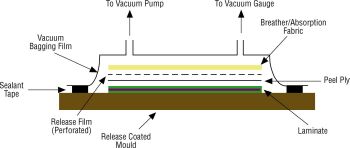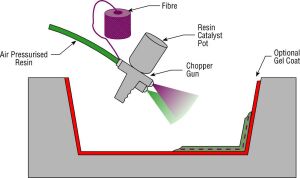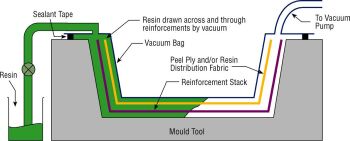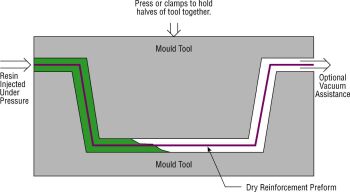
Hand lay-up
Home > Organizing your composite workshop
If you want to start working with composites, you need some basic materials
and equipment. In this section, we give a brief overview of the most common
raw materials and production processes that are fitted for use at home.
Last but not least, a few words are said about health and safety instructions.
All hands-on information is given in the section Let's go to work.
| Raw materials | top |
Moulding materials, resins and fibre reinforcement are the most needed raw materials for making composites. Additionally, more advanced compounds such as pre-pregs can be considered. Finally, release agents and gelcoats can be very useful.
[1] Moulding materials
If you want to make a composite component with a certain shape, you need a mould. The vocabulary is important in composite moulding:
piece : the finished product, which you are making.
plug : the actual item to be duplicated in fiberglass or other composite materials, which is used to construct the mould. The plug can be the actual part or a custom-fabricated shape, made from virtually any type of material.
mould : the item from which the piece will be made. There are two main types of moulds, male and female. A male mould is identical to the item being duplicated, and the piece is made over the mould. A female, or cavity, mould is the reverse of the item to be duplicated, and the piece is made inside the mould. The word can also be used to describe the composite fabrication process: moulding a part.
Summarized, the mould is a mirror image of the part. To create a mould, a master (plug) is required. The master can be an actual part, or can be fabricated out of wood, foam, plaster, or clay. The exact shape and finish of the master will be transferred to the mould. Once the master is completed, it is polished, waxed and the mould is built up on the master. The fabrication technique of the mould is similar to fabricating a fiberglass part except that tooling materials (gel coat, resins, and cloth) are used to provide a durable mould that has low shrinkage and good dimensional stability. Once the mould is laminated, it is reinforced with wood, fiberglass or metal structure to ensure that it retains the proper shape. Then the mould is removed from the master and put into production.
A very instructive guide to composite moulding is the DVD
"Composite molding made easy" by Bill Hayman. It can be ordered from
the website
http://home.paonline.com/hayman/PAGE3.htm.
Other useful manuals can be found on the website
http://www.fiberglassmoldmanual.com/.
A nice realization is shown on
http://www.speedace.info/composites/mould_making.htm.
A lot of materials can be used for making moulds:
For hands-on information see the section Let's go to work.
[2] Resins
The most popular resins for home made composites are epoxies, unsaturated polyester and vinylester. All these resins are thermosetting resins. Epoxies, polyesters and vinylesters represent two resin families. Epoxies belong to a family of resins which are epoxy functional, which means they can be cured with amine curing agents at room temperatures to form excellent adhesives and composite resins. Polyesters and vinylesters belong to another family of resins containing an unsaturated polyester or hybridized vinylester backbone which is catalyzed with a peroxide (normally Conap and MEKP) to condense into a cross-linked solid resin.
unsaturated polyester (UP) : unsaturated polyester is a thermosetting resin. It has the advantage of being extremely inexpensive when compared with other thermoset resins i.e. vinylesters and epoxies. If the upside is cheap pricing, the down side includes poor adhesions, high water absorption, high shrinkage, and high VOC's (volatile organic compounds). Polyester resins are only compatible with glass fibres. Polyester is best suited for applications insensitive to weight and do not require high adhesion or fracture toughness. For instance if a simple inexpensive solid fiberglass part must be fabricated in open tooling in one operation and requires no secondary bonding. If shape accuracy is not critical, resistance to water is of no concern, and ventilation of the workspace is excellent, then polyester's a great candidate.
vinylester : vinylesters represent a resin development step in the right direction. While still utilizing a polyester resin type of cross-linking (i.e. peroxide cured), these hybrid resins are toughened with epoxy molecules within the backbone. Shrinkage is less of a concern with vinylesters and prerelease of the part from the mold is reduced. The toughening effect of the resin modifications makes for a better resistance to micro fracturing and some of the secondary functionality of the backbone assists in adhesion to substrates. Resistance of vinylester resin to moisture is good. The down side of the vinylesters include sensitivity to mixing, handling, high VOC's (in the form of styrene), atmospheric moisture and temperature sensitivity (sometimes it just will not cure). Good tough vinylester is also quite pricey when compared to polyesters, in fact the dollars per pound approach that of epoxies. Vinylesters definitely represent an improvement over polyesters when considering standard peroxide curing, however adhesion to dissimilar and already cured substrates is still far below perfect. Vinylester resins only show good fiber adhesion to standard glass fiber, standard low adhesions to more exotic fibers (Kevlar/carbon fiber) and wood.
epoxy : Epoxies represent some of the most versatile resins available to the composite manufacturer. Generally, in all categories of work, the builder/repairer will realize the greatest degree of bond strength, waterproofing and toughness with well formulated epoxies. New generation epoxies are VOC free and have curing systems which are phenol free (representing a safe step forward for all resin users). Whether a part or repair is made of wood, carbon, Kevlar, fiberglass, core material or hybrids of the above, epoxies will wet and permanently stick to the composite.
[3] Dry fibre reinforcements
The most widely used fibres in industry are glass fibre and carbon fibre. As carbon fibre is much more expensive than glass fibre, glass fibre is the first choice for home made composites. It can be bought in different reinforcement types:
rovings : a loosely associated bundle of untwisted fibre filaments or strands. The weight of the roving is expressed in tex. This is a unit for linear density, equal to the weight in grams of 1 kilometer of fibre roving.
chopped strand mats (CSM) : chopped strand mats are a non-woven material which, as its name implies, consists of randomly orientated chopped strands of glass which are held by a PVA emulsion or a powder binder. Today, chopped strand mat is rarely used in high performance composite components as it is impossible to produce a laminate with a high fibre content and, by definition, a high strength-to-weight ratio.
fabrics : for applications where more than one fibre orientation is required, a fabric combining 0° and 90° fibre orientations is useful. Woven fabrics are produced by the interlacing of warp (0°) fibres and weft (90°) fibres in a regular pattern or weave style. The fabric's integrity is maintained by the mechanical interlocking of the fibres. Drape (the ability of a fabric to conform to a complex surface), surface smoothness and stability of a fabric are controlled primarily by the weave style. The most common weave styles are plain weave, satin weave and twill weave.
unidirectional fabrics : a unidirectional (UD) fabric is one in which the majority of fibres run in one direction only. A small amount of fibre or other material may run in other directions with the main intention being to hold the primary fibres in position, although the other fibres may also offer some structural properties.
multiaxial fabrics : in recent years multiaxial fabrics have begun to find favour in the construction of composite components. These fabrics consist of one or more layers of long fibres held in place by a secondary non-structural stitching tread. The main fibres can be any of the structural fibres available in any combination. The stitching thread is usually polyester due to its combination of appropriate fibre properties (for binding the fabric together) and cost. The stitching process allows a variety of fibre orientations, beyond the simple 0°/90° of woven fabrics, to be combined into one fabric.
[4] Prepregs
More advanced hobbyists can make use of prepregs. Prepreg is a term for "pre-impregnated" composite fibres. These usually take the form of a weave or are uni-directional. They already contain an amount of the matrix material used to bond them together and to other components during manufacture. The prepreg are mostly stored in cooled areas since activation is most commonly done by heat. Hence, composite structures built of prepregs will mostly require an oven or autoclave to cure out.
[5] Release agents and gelcoats
A release agent is any of a number of materials applied to the mold surface before part fabrication, in order to aid in the release of the piece from the mold. These could be waxes, oils or specialty release coatings such as PVA.
The term gel coat is often used generically to describe any resin-based surface coating, but the term technically applies to polyester-based materials. The term surface coat can be used to describe either epoxy or polyester materials. Surface coats are specially formulated, thickened versions of resins which can be applied to the surface of a mold or piece to serve as a cosmetic and protective coating.
[6] Core materials
If you would like to produce sandwich composites, you need a core material. Foams are one of the most common forms of core material. They can be manufactured from a variety of synthetic polymers including polyvinyl chloride (PVC), polystyrene (PS), polyurethane (PU), polymethacrylamide, polyetherimide (PEI) and styreneacrylonitrile (SAN). They can be supplied in densities ranging from less than 30kg/m3 to more than 300kg/m3, although the most used densities for composite structures range from 40 to 200 kg/m3. They are also available in a variety of thicknesses, typically from 5mm to 50mm.
More expensive core materials are balsa wood and aluminium honeycomb.
| Production processes | top |
Most industrial production processes for composites are difficult to
implement at home. Autoclave, compression moulding, injection moulding, tape winding,
filament winding,... require specialized and expensive equipment.
Luckily, a pair of hands and a brush are enough to start with hand lay-up.
And with a small investment for a vacuum pump, vacuum infusion can bring your
composite product to industrial quality standards. Below a short overview is given
of the manufacturing processes suitable for home production. The information
is compiled from the
Guide to Composites - Manufacturing of the
Netcomposites website
and the Overview of composite processes of the
American Composites Manufacturers Association.
[1] Hand lay-up
Hand lay-up is an open molding method suitable for making a wide variety of composites products including: boats, tanks, bathware, housings, RV/truck/auto components, architectural products, and many other products ranging from very small to very large. Production volume per mold is low; however, it is feasible to produce substantial production quantities using multiple molds.
First a gelcoat is applied to the mold using a spray gun for a high-quality surface. When the gel coat has cured sufficiently, roll stock fiberglass reinforcement is manually placed on the mold. The laminating resin is applied by pouring, brushing, spraying, or using a paint roller. FRP rollers, paint rollers, or squeegees are used to consolidate the laminate, thoroughly wetting the reinforcement, and removing entrapped air. Subsequent layers of fiberglass reinforcement are added to build laminate thickness. Low density core materials, such as end-grain balsa, foam, and honeycomb, are commonly used to stiffen the laminate to produce sandwich construction.
 |
|
Hand lay-up |
More detailed information can be found in the section Wet/Hand Lay-up of the Netcomposites website.
[2] Vacuum bagging
The mechanical properties of open-mold laminates can be improved with vacuum bagging. By reducing the pressure inside the vacuum bag, external atmospheric pressure exerts force on the bag. The pressure on the laminate removes entrapped air, excess resin, and compacts the laminate. A higher percentage of fiber reinforcement is the result. Additionally, vacuum bagging reduces styrene emissions. Vacuum bagging can be used with wet-lay laminates and prepreg advanced composites. In wet lay-up bagging the reinforcement is saturated using hand lay-up, then the vacuum bag is mounted on the mold and used to compact the laminate and remove air voids.
In the case of pre-impregnated advanced composites molding, the prepreg material is laid-up on the mold, the vacuum bag is mounted and the mold is heated or the mold is placed in an autoclave that applies both heat and external pressure, adding to the force of atmospheric pressure. The prepreg-vacuum bag-autoclave method is most often used to create advanced composites used in aircraft and military products.
In the simplest form of vacuum bagging, a flexible film (PVA, nylon, mylar, or polyethylene) is placed over the wet lay-up, the edges sealed, and a vacuum drawn. A more advanced form of vacuum bagging places a release film over the laminate, followed by a bleeder ply of fiberglass cloth, non-woven nylon, polyester cloth, or other material that absorbs excess resin from the laminate. A breather ply of a non-woven fabric is placed over the bleeder ply, and the vacuum bag is mounted over the entire assembly. Pulling a vacuum from within the bag uses atmospheric pressure to eliminate voids and force excess resin from the laminate. The addition of pressure further results in high fiber concentration and provides better adhesion between layers of sandwich construction. When laying non-contoured sheets of PVC foam or balsa into a female mold, vacuum bagging is the technique of choice to ensure proper secondary bonding of the core to the outer laminate.
 |
|
Vacuum bagging |
More detailed information can be found in the section Vacuum Bagging of the Netcomposites website.
[3] Spray-up
Spray-up or chopping is an open mold method similar to hand lay-up. A chopped laminate has good conformability and is sometimes faster than hand lay-up in molding complex shapes. In the spray-up process the operator controls thickness and consistency, therefore the process is more operator dependent than hand lay-up. Although production volume per mold is low, it is feasible to produce substantial production quantities using multiple molds.
As with hand lay-up, gel coat is first applied to the mold prior to spray-up of the substrate laminate. Continuous strand glass roving and catalyzed resin are fed through a chopper gun, which deposits the resin-saturated "chop" on the mold. The laminate is then rolled to thoroughly saturate the glass strands and compact the chop. Additional layers of chop laminate are added as required for thickness. Roll stock reinforcements, such as woven roving or knitted fabrics, can be used in conjunction with the chopped laminates. Core materials of the same variety as used in hand lay-up are easily incorporated.
 |
|
Spray-up |
More detailed information can be found in the section Spray Lay-up of the Netcomposites website.
[4] Vacuum infusion process (VIP)
Vacuum infusion is a variation of vacuum bagging where the resin is introduced into the mold after the vacuum has pulled the bag down and compacted the laminate. The method is defined as having lower than atmospheric pressure in the mold cavity. The reinforcement and core material are laid-up dry in the mold. This is done by hand and provides the opportunity to precisely position the reinforcement. When the resin is pulled into the mold the laminate is already compacted; therefore, there is no room for excess resin. Very high resin to glass ratios are possible with vacuum infusion and the mechanical properties of the laminate are superior. Vacuum infusion is suitable to mold very large structures and is considered a low volume molding process.
The mold may be gel coated in the traditional fashion. After the gel coat cures, the dry reinforcement is positioned in the mold. This includes all the plies of the laminate and core material if required. A perforated release film is placed over the dry reinforcement. Next a flow media consisting of a coarse mesh or a "crinkle" ply is positioned, and perforated tubing is positioned as a manifold to distribute resin across the laminate. The vacuum bag is then positioned and sealed at the mold perimeter. A tube is connected between the vacuum bag and the resin container. A vacuum is applied to consolidate the laminate and the resin is pulled into the mold.
 |
|
Vacuum infusion process (VIP) |
More detailed information can be found in the section Infusion Processes of the Netcomposites website.
[5] Resin transfer moulding (RTM)
Resin transfer molding is an intermediate volume molding process for producing composites. The RTM process is to inject resin under pressure into a mold cavity. RTM can use a wide variety of tooling, ranging from low cost composite molds to temperature controlled metal tooling. This process can be automated and is capable of producing rapid cycle times. Vacuum assist can be used to enhance resin flow in the mold cavity.
The mold set is gel coated conventionally, if required. The reinforcement (and core material) is positioned in the mold and the mold is closed and clamped. The resin is injected under pressure, using mix/meter injection equipment, and the part is cured in the mold. The reinforcement can be either a preform or pattern cut roll stock material. Preforms are reinforcement that is pre-formed in a separate process and can be quickly positioned in the mold. RTM can be done at room temperature; however, heated molds are required to achieve fast cycle times and product consistency. Clamping can be accomplished with perimeter clamping or press clamping.
 |
|
Resin transfer moulding (RTM) |
More detailed information can be found in the section Resin Transfer (RTM) of the Netcomposites website.
[6] Autoclave
Moulding of prepregs is usually done in an autoclave
(effectively a pressurised oven). The autoclave
process offers one of the highest manufacturing standards for composites.
Fabrics and fibres are pre-impregnated by the prepreg manufacturer,
under heat and pressure or with solvent, with a pre-catalysed resin.
The catalyst is largely latent at ambient temperatures giving the
materials several weeks, or sometimes months, of useful life when
defrosted. However to prolong storage life the materials are stored
frozen. The resin is usually a near-solid at ambient temperatures,
and so the pre-impregnated materials (prepregs) have a light sticky
feel to them, such as that of adhesive tape. Unidirectional materials
take fibre direct from a creel, and are held together by the resin alone.
The prepregs are laid up by hand or machine onto a mould surface, vacuum bagged and then heated to typically 120-180°C. This allows the resin to initially reflow and eventually to cure. The autoclave provides additional pressure for the moulding which can apply up to 5 atmospheres to the laminate.
 |
|
Autoclave |
More detailed information can be found in the section Prepreg moulding of the Netcomposites website.
| Health and safety instructions | top |
Below the precautions, related to resins, fibres and dust are listed. This text is based on an excerpt from the article on the Composite About.com website.
Polymers used as matrices, and those used as adhesives, probably pose
the highest hazard when working with composites. Most resins do not pose
a respiratory hazard, but some curing agents and many solvents used in
conjuction with resins do. Thermoplastics are pretty much inert and pose
little or no risk (except for burns when they are melted).
The primary hazard with resins is direct contact. Of course, eye contact
with any foreign substance should always be avoided, but it is also
important to avoid skin contact with resins, curing agents, and solvents.
Problems range from staining and irritation to organ damage, and many
substances are suspected or known carcinogens.
Every resin has its own Material Safety Data Sheet (MSDS).
A Material Safety Data Sheet (MSDS) is designed to provide both workers
and emergency personnel with the proper procedures for handling or
working with a particular substance. MSDS's include information such
as physical data (melting point, boiling point, flash point etc.),
toxicity, health effects, first aid, reactivity, storage, disposal,
protective equipment, and spill/leak procedures. These are of particular
use if a spill or other accident occurs. A good starting point to find
MSDS's on the Internet is the website
http://www.ilpi.com/msds/.
Most resins are skin sensitizers, meaning that symptoms can develop
or become worse after repeated or prolonged contact. Protective clothing,
including goggles and gloves, should always be worn when mixing and
handling resins. If you do get a resin or adhesive on your skin, wash
immediately with soap and water or a waterless cleaner such as those
with a citrus base (some materials are water soluble, others are not).
Do not use a solvent such as acetone or alcohol. Not only can this be
a hazard in itself, but the solvents will remove skin oils which act
as a protective barrier.
When selecting gloves, make sure they protect against the materials
you are handling. Many gloves dissolve in solvents. Most safety catalogs
list the materials gloves are resistant to. If you're not sure, fill a
glove finger with the material in question and wait a while to see if
the glove holds up.
A special note should be made for polyester. Unsaturated polyester is
widely used in hand lay-up and home-made composites. It contains a large
fraction (30%-45%) of styrene, a colorless liquid that evaporates easily.
For many years now, there are intensive debates about the hazards of styrene
exposure, but nevertheless, everybody agrees that a proper protection
(respiratory protective equipment, goggles and gloves) and good ventilation are essential when working with
styrene. Even better is wearing a chemical cartridge/canister respirator.
More information can be found in the
Respiratory
protection manual of the Occupational Safety & Health Administration (OSHA) of
the US Deparment of Labour.
Compared to resins, fibres are relatively inert. The primary hazard
is mechanical irritation, either of the skin or the upper respiratory
tract. Most, if not all, fibres have too large a diameter to be respirable,
which means they do not enter the lungs. Carbon fibres are close, and
carbon dust created by machining may be respirable. Aramid (Kevlar) fibres
are much too large to be respirable, but they can fracture into small
fibrils which are respirable.
Mechanical irritation is itching after direct contact. Aramids cause no
irritation for most people, but glass and carbon do. Most fibres have a
sizing (often an epoxy or other resin) which can also cause chemical
irritation, and this can be mistaken for mechanical irritation.
After cure, fibres become very rigid and may stick out from poorly machined
or fractured surfaces. Such surfaces should be handled with care, because
it is very easy to get fibre splinters (or "snake-bites").
Finally, carbon fibres are electrically conductive. Although this doesn't
pose a direct health hazard, airborne fibres can short out electrical
equipment. Gloves should always be worn when handling resins, and these
will also protect against fibres in uncured composites. Only heavier
gloves will protect against sharp fibres on fracture surfaces.
Whenever dust is created (such as while machining), dust masks and protective clothing should be worn . Elastic cuffs will keep dust from getting inside protective suits. Of course, dust removal systems are also important (though shop-vacs can be shorted out by carbon fibre dust).
More information can be found in the manual of the Occupational Safety & Health Administration (OSHA) of the US Deparment of Labour.